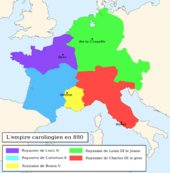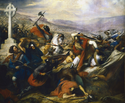Louis III of France
| Louis III | |
|---|---|
 | |
| King of West Francia | |
| Reign | 10 April 879 – 5 August 882 |
| Coronation | September 879 |
| Predecessor | Louis the Stammerer |
| Successor | Carloman II |
| Co-Monarch | Carloman II |
| Born | 863/865 St Denis |
| Died | 5 August 882 (aged 18–19/16–17) St Denis, Île-de-France, Neustria |
| Burial | |
| Dynasty | Carolingian |
| Father | Louis II |
| Mother | Ansgarde of Burgundy |
Louis III (863/65 – 5 August 882) was King of West Francia from 879 until his death in 882. Despite questions of his legitimacy and challenges against his ascendance to the monarchy, Louis would prove to be an effective leader during his reign, notable for the defeat of Viking invaders at the Battle of Saucourt-en-Vimeu in August 881 that would later be immortalized in the poem Ludwigslied. He also led a less successful military campaign against Boso of Provence with help from Charles the Fat.
The eldest son of Louis the Stammerer and Ansgarde of Burgundy, Louis endured questions of his legitimacy and refused to recognize him as the "true" King of West Francia, and upon the death of his grandfather and father in 877 and 879 respectively, ascended to the monarchy and ruled alongside his brother, Carloman II, following a deal in 880 at Amiens to split the throne between Neustria and Aquitania.
During his brief tenure as King, he was challenged by Duke Boso, who had ascended to King of Provence. After his victories in Mâcon and northern Provence, he unsuccessfully besieged Vienne alongside his cousin, Charles the Fat. Invasions from West Frankish and Louis the Younger were peacefully decided after the cession of Western Lotharingia in 880.
Louis' most important victory was the Battle of Saucourt-en-Vimeu in August 881. Viking raiders came into Saucourt following defeats in East Francia and the sacking of several cities in West Francia, Louis and his brother were able to repel the offensive and killed roughly 9,000 of the invaders.[2] However, the victory proved inconsequential, as Louis died nearly a year later in an accident and was succeeded by his brother. Contemporaries state that Louis was a popular King during his short reign, and describe him as "able and energetic".[3]
Early life
[edit]Louis was born in either 863 or 865 at St Denis and was the eldest son of Louis the Stammerer, King of Aquitaine, and his first wife, Ansgarde of Burgundy.[4] Due to the fact that his parents had married secretly and Ansgarde was later repudiated at Charles' insistence, Louis' legitimacy was largely questioned during his early life.
When Charles the Bald died in 877, followed by Louis the Stammerer on 10 April 879, Louis became King of West Francia. Some Frankish nobles advocated keeping Louis as the sole king, but another party favoured each brother ruling a separate part of the kingdom. In September 879, Louis was crowned at Ferrières Abbey.[5]
Reign
[edit]
Splitting the kingdom
[edit]When Louis III was crowned King of West Francia in September 879, approval was split between allowing Louis to rule alone or have the Kingdom be split. Ultimately, Carloman II and Louis made an agreement in March 880 at Amiens, dividing their father's kingdom, with Louis receiving Neustria and Carloman receiving Aquitania. As a result of this split, Boso, one of Charles the Bald's most trusted lieutenants and the Count of Vienne, renounced his allegiance to both brothers and appropriated the title of King of Provence.
Early reign; wars against Louis the Younger and Boso (879–880)
[edit]Invasions began nearly as soon as Louis III was crowned in 879, with dissident nobles and magnates from West Francia led by Louis the Younger, King of East Francia, continuing a campaign that had raged since 877. Louis and Carloman made a treaty at Ribemont in 880, giving East Francia the western part of Lotharingia and placating the parties.
In the summer of 880, Louis and Carloman went to war against Boso. The campaign started well at first, as the brothers captured Mâcon and the northern part of Provence within the first few months of the war.[6] They proceeded to unite their forces with those of their cousin, Charles the Fat, who brought armies from Italy, East Francia, and Alemannia into the war. Despite the added manpower, The siege of Vienne from August to November 880 proved unsuccessful and resulted in too many casualties for the war to continue, and the war ended in Louis' defeat.

(Charles Auguste Steuben, ca. 1837).

Military success against the Vikings (881)
[edit]The Viking raids against the Frankish kingdoms increased sharply around the middle of 880 and quickly turned into a large challenge. After the Viking defeat at Thimeon in the east, the raiders turned to the west and took Kortrijk, Arras, Cambrai, Amiens and Corbie between November 880 and July 881.
Louis and his brother intercepted the Vikings at Saucourt-en-Vimeu on 3 August 881, catching them by surprise. In an extremely violent and bloody attack, according to the Annales Fuldenses, the West Frankish forces slaughtered as many as 9,000 raiders and won an important, decisive victory.
Louis, at a mere 16 years of age, was widely celebrated by the people of both Frankish kingdoms. In East Francia, the Old High German poem Ludwigslied celebrated Louis' heroism, piety and poise in the battle, while in West Francia, a chanson de geste titled Gormond et Isembart was inspired by the battle and written a few hundred years later.
Death and legacy
[edit]Louis III died suddenly on 5 August 882, aged around 17, at Saint-Denis. According to legend, he was chasing after a girl who was retreating to her father's house on horseback and hit his head on the lintel of a low door, taking a bad fall and breaking his skull.[7] Because Louis III had no children, his brother Carloman II became the sole king of West Francia, and the young king was buried in the royal mausoleum of the Basilica of Saint-Denis.[8]
Louis' death was incredibly damaging to the West Frankish war against the Vikings, and despite his massive victory at Saucourt, his brother and successor could not match his level of success and died in 884. However, his death united the kingdom of West Francia under one ruler and his reign set the stage for later Frankish unity.
See also
[edit]- Charles VIII of France, another French king who died after hitting his head on a lintel.
- Carloman II, the successor of Louis III.
References
[edit]- ^ statue (gisant) : Louis III, roi de France, POP (Base Mérimée), French Ministry of Culture
- ^ Gillmor 2010, p. 224.
- ^ "Louis III | Carolingian Dynasty, West Francia, Aquitaine | Britannica". www.britannica.com. 1 August 2024. Retrieved 29 August 2024.
- ^ McKitterick 1999, p. 258.
- ^ Jackson 1995, p. 130.
- ^ Venning 2017, pp. 392–393.
- ^ Bartlett 2020, p. 241.
- ^ Nelson 2000, p. 166.
Sources
[edit]- Bartlett, Robert (2020). Blood Royal: Dynastic Politics in Medieval Europe. Cambridge University Press.
- Jackson, Richard A., ed. (1995). Ordines Coronationis Franciae. Vol. 1. University of Pennsylvania Press.
- McKitterick, Rosamond (1999). The Frankish Kingdoms under the Carolingians. Pearson Education Limited.
- Mueller-Vollmer, Tristan; Wolf, Kirsten, eds. (2022). "Chronology: 881". Vikings: An Encyclopedia of Conflict, Invasions, and Raids. ABC-CLIO.
- Nelson, Janet L. (2000). "Carolingian royal funerals". In Theuws, Frans; Nelson, Janet Laughland (eds.). Rituals of Power: From Late Antiquity to the Early Middle Ages. Brill.
- Venning, Timothy (2017). A Chronology of Early Medieval Western Europe: 450–1066. Routledge.
- Green, Dennis H. "The Ludwigslied and the Battle of Saucourt", in Judith Jesch (ed.), The Scandinavians from the Vendel Period to the Tenth Century (Oxford: Boydell Press, 2002), 281–302.
- Fouracre, Paul. "The Context of the Old High German Ludwigslied", Medium Aevum, 46 (1985), 87–103.
- MacLean, Simon. Kingship and Politics in the Late Ninth Century: Charles the Fat and the end of the Carolingian Empire. Cambridge: Cambridge University Press, 2003.




